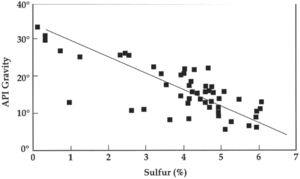Elemental parameter data for oil–oil and oil–source rock correlations
| Exploring for Oil and Gas Traps | |

| |
| Series | Treatise in Petroleum Geology |
|---|---|
| Part | Critical elements of the petroleum system |
| Chapter | Oil–oil and oil–source rock correlations |
| Author | Douglas W. Waples, Joseph A. Curiale |
| Link | Web page |
| Store | AAPG Store |
Elemental parameters refer to the bulk composition of the samples. These parameters include sulfur and (less commonly) nitrogen, nickel, and vanadium content. In rare cases, we may have data on other trace elements. Data on the gross composition of the oil are also included in this category.
Sulfur[edit]
High-sulfur and low-sulfur oils have fundamentally different origins. Most high-sulfur oils come from nonclastic source rocks. Although some extremely rich clastic source rocks like the Kimmeridge Clay of the North Sea also yield moderately high-sulfur oils, most clastic source rocks yield oils with less than 0.5% sulfur by weight. However, sulfur content is also a function of maturity.
Maturity effects[edit]

The trend in sulfur content within a single megafamily of high-sulfur oils is a function of API gravity, which normally increases with increasing maturity. Thus, highly mature oils that were originally high in sulfur (e.g., from a carbonate source) can have low sulfur content, as evidenced in the figure below. Therefore, unless the maturity levels of all samples are similar, or unless some correction for maturity is made, sulfur content can be misleading as a correlation parameter. Sulfur content decreases with increasing maturity (API gravity) in low-sulfur oils as well, although the range of variation is usually too small to be of much practical value.
Figure 1 is a set of southern California oils showing wide variation in both gravity and sulfur content. Several workers attribute this relationship to factors such as migration and maturity differences, as well as to source variations.[2]
Gross composition[edit]
Most common is the breakdown of the heavier (C15+) fraction into saturated hydrocarbons (saturates), aromatic hydrocarbons (aromatics), lighter nonhydrocarbons (NSOs [nitrogen, sulfur, oxygen], polars, or resins), and heavier nonhydrocarbons (asphaltenes). Oils with terrestrial input often have high saturate/aromatic ratios, whereas those from carbonate sources have low saturate/aromatic ratios and high content of nonhydrocarbons. Saturate–aromatic ratios probably increase slightly with increasing maturity and decrease with biodegradation.
Other parameters[edit]
Other parameters included in this category are API gravity (or density), color, wax content, pour point, and viscosity. Most of these parameters are of little value, however, because they are highly susceptible to transformation processes.
References[edit]
- ↑ Kennicutt, M. C., and J. M. Brooks, 1988, Surface geochemical exploration studies predict API gravity off California: Oil & Gas Journal, September 12, p. 101–106.
- ↑ Orr, W. L., 1986, Kerogen/asphaltene/sulfur relationships in sulfur-rich Monterey oils: Organic Geochemistry, vol. 10, p. 499–516., 10., 1016/0146-6380(86)90049-5